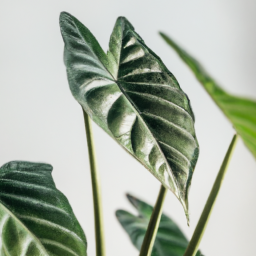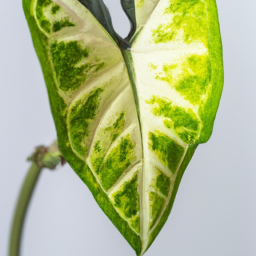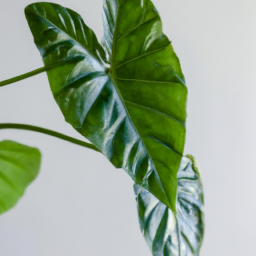
Are you a plant lover looking to expand your collection with some unique and beautiful varieties? If so, you may want to consider adding different types of syngoniums to your indoor garden. Syngoniums, also known as arrowhead plants, are popular houseplants known for their attractive foliage and easy care requirements. In this blog post, we will explore the various types of syngoniums available, highlighting their distinct characteristics and growing requirements. Whether you’re a seasoned plant parent or a beginner looking to green up your space, learning about the different types of syngoniums can help you choose the perfect addition to your plant family.
Common Types of Syngoniums
Syngoniums, also known as arrowhead plants, are popular houseplants known for their unique arrow-shaped leaves and easy care requirements. There are several different types of syngoniums available, each with its own distinct characteristics and growing requirements. In this guide, we will explore some of the most common types of syngoniums and how to care for them.
1. Syngonium Podophyllum
Syngonium podophyllum, also known as the arrowhead vine, is one of the most popular varieties of syngoniums. It is characterized by its arrow-shaped leaves that can vary in color from green to pink to white. This variety is easy to care for and can thrive in a variety of lighting conditions, making it a great choice for beginner plant enthusiasts.
To care for syngonium podophyllum, it is important to provide it with well-draining soil and water it regularly, allowing the top inch of soil to dry out between waterings. This plant prefers bright, indirect light but can also tolerate lower light conditions. Regular pruning will help maintain its bushy shape and encourage new growth.
Propagation of syngonium podophyllum can be done through stem cuttings, which should be taken from healthy, mature plants. Simply cut a section of stem with at least one node and place it in water or moist soil until roots develop. Once rooted, the new plant can be potted in a well-draining soil mix.
Overall, syngonium podophyllum is a versatile and low-maintenance plant that can add a touch of tropical elegance to any indoor space.
2. Syngonium Neon Robusta
Syngonium neon robusta is a striking variety of syngonium with vibrant neon green leaves that can add a pop of color to any room. This variety is a fast grower and can quickly fill out a pot with its lush foliage. Syngonium neon robusta thrives in bright, indirect light and prefers to be kept consistently moist but not waterlogged.
To care for syngonium neon robusta, it is important to provide it with a well-draining soil mix and water it regularly, ensuring that the soil remains evenly moist. This plant benefits from occasional misting to increase humidity levels and prevent the leaves from drying out.
Propagation of syngonium neon robusta can be done through stem cuttings, similar to syngonium podophyllum. Cuttings should be taken from healthy, mature plants and placed in water or moist soil until roots develop. Once rooted, the new plant can be potted in a well-draining soil mix.
Overall, syngonium neon robusta is a stunning and easy-to-care-for plant that is sure to brighten up any indoor space with its vibrant foliage.
3. Syngonium Macrophyllum
Syngonium macrophyllum, also known as the arrowhead vine, is a unique variety of syngonium with large, heart-shaped leaves that can reach impressive sizes. This variety is a slow grower compared to other syngoniums but is well worth the wait for its striking foliage. Syngonium macrophyllum thrives in bright, indirect light and prefers to be kept consistently moist but not waterlogged.
To care for syngonium macrophyllum, it is important to provide it with a well-draining soil mix and water it regularly, allowing the top inch of soil to dry out between waterings. This plant benefits from occasional misting to increase humidity levels and prevent the leaves from drying out.
Propagation of syngonium macrophyllum can be done through stem cuttings, similar to other varieties of syngonium. Cuttings should be taken from healthy, mature plants and placed in water or moist soil until roots develop. Once rooted, the new plant can be potted in a well-draining soil mix.
Overall, syngonium macrophyllum is a stunning and unique plant that is sure to make a statement in any indoor space with its impressive foliage and elegant growth habit.

Rare Varieties of Syngoniums
Syngoniums, also known as arrowhead plants, are popular houseplants known for their attractive foliage and easy care requirements. While there are many common varieties of syngoniums available, there are also some rare and unique varieties that are highly sought after by plant enthusiasts. In this article, we will explore some of the rare varieties of syngoniums that you may want to add to your collection.
Variegated Syngoniums
Variegated syngoniums are prized for their striking foliage patterns, featuring a mix of green, white, and sometimes pink or red colors. These rare varieties are highly sought after for their unique and eye-catching appearance. Variegated syngoniums require bright, indirect light to maintain their vibrant colors, and they should be watered when the top inch of soil feels dry. These plants can be propagated easily by taking stem cuttings and rooting them in water or soil.
One popular variegated syngonium variety is the Syngonium podophyllum ‘Pink Splash’, which features green leaves with pink speckles and splashes. Another sought-after variety is the Syngonium podophyllum ‘Confetti’, which has green leaves with white and pink speckles. Variegated syngoniums are a great addition to any plant collection and are sure to be a conversation starter in your home.
In addition to their aesthetic appeal, variegated syngoniums are also relatively easy to care for, making them suitable for both beginner and experienced plant owners. With proper care and attention, these rare varieties of syngoniums can thrive and bring beauty to your indoor space.
Rare Syngonium Cultivars
In addition to variegated varieties, there are also rare syngonium cultivars that are prized for their unique characteristics. One such cultivar is the Syngonium podophyllum ‘Neon Robusta’, which features bright green leaves with a neon yellow center. This rare variety is sure to stand out in any plant collection and is a favorite among syngonium enthusiasts.
Another rare syngonium cultivar is the Syngonium podophyllum ‘Maria Allusion’, which has dark green leaves with silver veins. This unique variety adds a touch of elegance to any indoor space and is a popular choice for plant collectors looking for something a little different.
Rare syngonium cultivars may require slightly different care than more common varieties, so it is important to research the specific needs of each cultivar before bringing them home. With the right care and attention, these rare syngonium varieties can thrive and become a focal point in your indoor garden.
Uncommon Syngonium Species
In addition to variegated varieties and rare cultivars, there are also uncommon syngonium species that are worth seeking out for their unique characteristics. One such species is Syngonium erythrophyllum, which features dark green leaves with red undersides. This uncommon species is a striking addition to any plant collection and is sure to turn heads with its bold colors.
Another uncommon syngonium species is Syngonium wendlandii, which has velvety green leaves with silver veins. This species is highly sought after for its elegant appearance and is a favorite among plant collectors looking for something a little different.
When caring for uncommon syngonium species, it is important to research their specific care requirements, as they may differ from more common varieties. With the right care and attention, these uncommon syngonium species can thrive and bring a touch of exotic beauty to your indoor space.
In conclusion, rare varieties of syngoniums offer a unique and eye-catching addition to any plant collection. Whether you opt for a variegated variety, a rare cultivar, or an uncommon species, these plants are sure to bring beauty and interest to your indoor garden. With proper care and attention, rare syngonium varieties can thrive and become a focal point in your home. So why not add a rare syngonium to your collection today and enjoy the beauty and uniqueness that these plants have to offer.

Popular Syngonium Cultivars
Syngoniums, also known as arrowhead plants, are popular houseplants known for their attractive foliage and easy care requirements. There are many different cultivars of syngoniums available, each with its own unique characteristics and colors. In this guide, we will explore some of the most popular syngonium cultivars and how to care for them.
Neon Robusta
Neon Robusta is a striking syngonium cultivar with bright neon green leaves that are sure to add a pop of color to any indoor space. This cultivar is known for its vibrant foliage and easy care requirements, making it a popular choice for beginner plant enthusiasts. Neon Robusta thrives in bright, indirect light and should be watered when the top inch of soil feels dry to the touch. It is important to avoid overwatering, as this can lead to root rot.
In terms of propagation, Neon Robusta can be easily propagated through stem cuttings in water or soil. Simply cut a healthy stem with at least one leaf node and place it in water or soil until roots develop. Once roots have formed, the new plant can be potted up in a well-draining potting mix. With proper care, Neon Robusta can grow into a lush and full plant that will brighten up any room.
Overall, Neon Robusta is a stunning syngonium cultivar that is perfect for adding a touch of color to your indoor plant collection. With its easy care requirements and striking foliage, it is sure to become a favorite among plant enthusiasts of all experience levels.
Pink Allusion
Pink Allusion is a beautiful syngonium cultivar with delicate pink and green leaves that create a soft and feminine look. This cultivar is prized for its unique coloration and compact growth habit, making it an ideal choice for small spaces or as part of a plant arrangement. Pink Allusion thrives in bright, indirect light and should be watered when the top inch of soil feels dry to the touch.
Propagation of Pink Allusion can be done through stem cuttings in water or soil, similar to Neon Robusta. Cut a healthy stem with at least one leaf node and place it in water or soil until roots develop. Once roots have formed, the new plant can be potted up in a well-draining potting mix. With proper care, Pink Allusion can grow into a lush and full plant that will add a touch of elegance to any room.
Overall, Pink Allusion is a stunning syngonium cultivar that is perfect for creating a soft and feminine look in your indoor plant collection. With its unique coloration and compact growth habit, it is sure to be a standout plant in any space.
White Butterfly
White Butterfly is a charming syngonium cultivar with white and green variegated leaves that resemble the wings of a butterfly. This cultivar is prized for its eye-catching foliage and easy care requirements, making it a popular choice for plant enthusiasts of all experience levels. White Butterfly thrives in bright, indirect light and should be watered when the top inch of soil feels dry to the touch.
Propagation of White Butterfly can be done through stem cuttings in water or soil, similar to Neon Robusta and Pink Allusion. Cut a healthy stem with at least one leaf node and place it in water or soil until roots develop. Once roots have formed, the new plant can be potted up in a well-draining potting mix. With proper care, White Butterfly can grow into a lush and full plant that will add a touch of whimsy to any room.
Overall, White Butterfly is a delightful syngonium cultivar that is perfect for adding a touch of whimsy to your indoor plant collection. With its eye-catching foliage and easy care requirements, it is sure to be a favorite among plant enthusiasts.
Here are the Essential Points
Syngoniums, also known as arrowhead plants, are popular houseplants due to their attractive foliage and easy care requirements. There are several types of syngoniums available, each with its own unique characteristics and colors. The most common type is the Syngonium podophyllum, which features arrow-shaped leaves in various shades of green, white, and pink. This variety is perfect for beginners as it is low-maintenance and can thrive in a variety of lighting conditions.
Another popular type of syngonium is the Syngonium erythrophyllum, which has striking red and green leaves that add a pop of color to any indoor space. This variety requires a bit more attention than the Syngonium podophyllum, as it prefers bright, indirect light and consistently moist soil. For those looking for a more compact option, the Syngonium neon robusta is a great choice. This variety has vibrant neon green leaves that are smaller in size, making it perfect for small spaces or terrariums. Overall, there is a syngonium variety to suit every plant lover’s taste and skill level.
Common Questions and Answers:
Q1: What are the different types of syngoniums?
Syngoniums come in various types, including Syngonium podophyllum, Syngonium erythrophyllum, Syngonium macrophyllum, and Syngonium wendlandii. Each type has its own unique leaf shape, color, and growth pattern.
Q2: How can I differentiate between the different types of syngoniums?
You can differentiate between different types of syngoniums based on their leaf shape, color, and size. Syngonium podophyllum, for example, has arrowhead-shaped leaves, while Syngonium erythrophyllum has red-colored leaves.
Q3: Are there rare or exotic types of syngoniums available?
Yes, there are rare and exotic types of syngoniums available, such as Syngonium wendlandii, which has uniquely shaped leaves with silver veins. These rare varieties are highly sought after by plant collectors.
Q4: What are the care requirements for different types of syngoniums?
While care requirements may vary slightly between different types of syngoniums, in general, they prefer bright, indirect light, well-draining soil, and regular watering. It’s important to research the specific care needs of the type of syngonium you have.
Q5: Can I propagate different types of syngoniums in the same way?
Yes, you can propagate different types of syngoniums in the same way, typically through stem cuttings or division. Make sure to use a sharp, clean cutting tool and follow proper propagation techniques to ensure success.
Dr. Olivia Green is a botanist with over two decades of experience in indoor plant cultivation. She holds a Ph.D. in Plant Biology and has dedicated her career to researching plant behavior in controlled environments. Dr. Green is passionate about helping plant enthusiasts master the art of indoor gardening through her extensive knowledge and practical insights.


